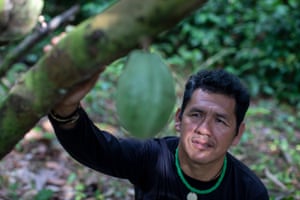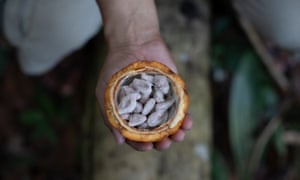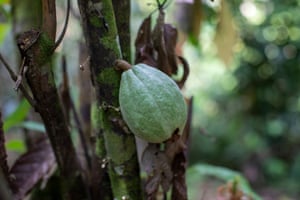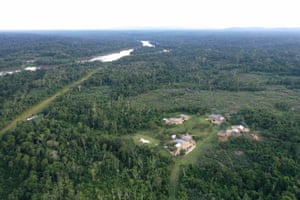https://www.theguardian.com/environment/2020/jan/25/cacao-not-gold-chocolate-trees-offer-future-to-amazon-tribes-aoe
Cacao not gold: ‘chocolate trees’ offer future to Amazon tribes
In Brazil’s largest indigenous reserve thousands of saplings have been planted as an alternative to profits from illegal gold mining
The villagers walk down the grassy landing strip, past the wooden hut housing the health post and into the thick forest, pointing out the seedlings they planted along the way. For these Ye’kwana indigenous men, the skinny saplings, less than a metre high, aren’t just baby cacao trees but green shoots of hope in a land scarred by the violence, pollution and destruction wrought by illegal gold prospecting. That hope is chocolate.
“We want to plant and develop income for the community,” says Júlio Ye’kwana, 39, president of the Ye’kwana people’s Wanasseduume association, which came up with the idea. “And it is not destructive for the forest.”
In the last two years, thousands of Theobroma cacao trees have been planted near Waikás and other villages in the remote Yanomami indigenous reserve. The saplings were planted within the forest because cacao likes shade, an idea borrowed from agroforestry techniques successfully used for cacao elsewhere in the Amazon.
Villagers hope that within a few years rich, organic chocolate will be produced from the golden cacao fruit these trees bear. The project – run by the reserve’s indigenous associations Wanasseduume and Hutukara with Brazilian non-profit group Instituto Socioambiental (ISA) – is ambitious, but experts say it is based on a potential commercial reality.
Located in the far north of the Brazilian Amazon, Yanomami is Brazil’s biggest indigenous reserve, spread over 9.6 million hectares (23.7m acres). But its wild, mountainous forests are overrun by an estimated 20,000 wildcat goldminers, called garimpeiros.
Ye’kwana and Yanomami indigenous leaders called for the garimpeiros to be expelled with a letter and group photo later shared by actor Leonardo DiCaprio.
But the country’s far-right president, Jair Bolsonaro, has claimed that indigenous people really yearn for white society’s consumer lifestyles, said the Yanomami reserve is too big for its population and may be sued for racism by the Brazilian Indigenous People’s Association after comments during a Facebook Live broadcast this week. “The indigenous changed, they are evolving,” he said. “Indigenous are increasingly becoming human beings just like us.”
“The president says indigenous people are poor. We are not poor. Nobody goes hungry here,” says Júlio Ye’kwana. “We eat for free.”
The Guardian was invited to visit by the Hutukara Yanomami Association, founded by Davi Kopenawa, a leader and shaman who fought to create the reserve with photographer Claudia Andujar and non-profit group Survival International.
Five villages from both tribes are participating in the cacao project. Cacao trees are native in this area, but around 3,000 new seedlings have been planted to boost production, with 7,000 expected by the end of 2021.
Edmilson Estevão shins up a mature cacao tree to bring down some of the heavy yellow fruit. Inside each thick shell is a sticky cluster of seeds, packed in a sweet, delicious, pale paste. These are dried and roasted to make chocolate.
“One tree like this can bear up to 20 fruit,” says Estevão, 33, who was raised in Waikás and works for Wanasseduume.
These mature trees were planted more than a decade ago by Luiz Ye’kwana. He was murdered by garimpeiros after refusing to transport them upriver, villagers say.
Violence is a recurrent problem around garimpeiros, as becomes graphically evident the next day. Outside the health post, two garimpeiros are wrapping a dead body in a tarpaulin. The dead man was known as Eduardo at Tatuzão, the illegal gold mining camp two hours’ boat ride upstream. But everybody uses an alias there. The nurse who fought to save his life discovered that his real name was Ralf Cabral and he was 21. The garimpeiros say he shot himself.
His eyes are wide open, he is dressed in black football shorts, and there is a bandage over the bullet hole in his chest. “He’s been here for five months, and now he’s done this,” says Manoel dos Santos, 49, wrapping Cabral’s body. “I have no idea why.”
The health post was built by the Brazilian government to serve the village’s 150 Ye’kwana people, but also handles hundreds of garimpeiro cases each year, including miscarriages, malaria, snake bites, broken limbs, knife and gunshot wounds. “It’s a war here,” says Giselle Dornellas, 33, the nurse who kept Cabral alive for 12 hours.
Garimpo gold is seductive and buys televisions and phones. Four villagers work as boat pilots, others deliver food, and even the village community centre was built with garimpo money.
But the cacao project will offer an alternative, says its coordinator, ISA anthropologist Moreno Saraiva. “We’re trying to build another possible future,” he says. “It will take five years, but if we don’t do this now there will never be another alternative.”
The project was inspired by another ISA project that since 2016 has produced edible mushrooms in other Yanomami villages. On paper the cacao project makes sense. Most of the world’s cacao production is in Africa, but the plant is native to the Amazon and was domesticated in South America 4,000 years ago. The Aztecs used the beans as money. And a Spanish map from 1775 called the Yanomami area the “Pais de los cacaguales” – or “Cacao Land”.
“You have a traditional and well-spread presence of native cocoa trees,” says food researcher Roberto Smeraldi, vice-president of the Atá Institute founded by Alex Atala – the Michelin starred Brazilian chef renowned for using ingredients from the Amazon.
Smeraldi recruited César de Mendes, a chocolate specialist based near the Amazon city of Belém for the cacao project. ISA and the indigenous associations organised well-attended workshops with de Mendes in Waikás in 2018 and 2019 to show villagers how cacao seeds are processed to make chocolate.
Fruit from mature Yanomami cacao trees was used to produce a trial run. A thousand 50g bars of the bitter, delicious Yanomami chocolate quickly sold out at an event in São Paulo last December, despite a £9.20 price tag. Customers were happy to pay to compensate for the destruction caused by garimpo, de Mendes says. Profits went to both indigenous associations.
“I am not being much of a businessman, I am being more an activist,” de Mendes says. “We are selling to an aware public.”
He learned his trade from his grandmother, who made her own chocolate in an Amazon riverside community, and singles out the Yanomami chocolate’s notes of almond oil and flowers, light acidity and sweetness. “These give this cacao its own personality,” he says.
Smeraldi argues that the Yanomami cacao’s origins in this isolated jungle could make its genetic properties attractive to the world cacao industry, which is vulnerable to climate change and blights such as the witches’ broom fungus which ravaged cacao plantations in the state of Bahia three decades ago.
And the chocolate’s strong, persistent taste could find its niche in the booming, specialist chocolate market, he says. Distinct fruits and flavours are increasingly sought out, as happened with wine when customers graduated from ordering “red” or “white” to specific grapes and countries. “It is a product of high complexity,” Smeraldi says.
Photograph: João Laet/The Guardian
According to a report from Research and Markets, the global premium chocolate market is growing at nearly 10% a year, and demand for organic, dark and “clean label” chocolate is a key market trend. In Ecuador, Kichwa indigenous people have been producing their own organic Kallari chocolate, sold worldwide, since 2007.
But Bolsonaro’s government is heading in the opposite direction. It is sending a bill to Congress to legalise garimpo, which the energy minister, Admiral Bento Albuquerque, recently presented to European diplomats.
The news chills villagers in Waikás. “If Bolsonaro succeeds, it’s the end for our people,” says Eduardo da Silva, 65. But it has also bolstered support for the cacao project.
“We have to do it for our children, not for us,” says Felipe Gimenes, 45, the village schoolteacher and former chief who planted an extra 200 cacao seedlings on his own plot. “This is our opportunity.”
- This piece was edited on 28 January 2020 to include a more accurate translation of remarks made by Brazilian president Jair Bolsonaro
Find more age of extinction coverage here, and follow biodiversity reporters Phoebe Weston and Patrick Greenfield on Twitter for all the latest news and features
.png)








沒有留言:
張貼留言